Henri Matisse

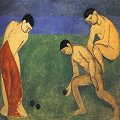 Henri Matisse, French artist, known for his use
of color to convey emotional expression, and his fluid, direct
and original painting style. As a printmaker, but principally as a
painter, Matisse is one of the best-known artists of the 20th century.
His mastery of the expressive language of color and drawing won him
recognition as a leading figure in modern art. Early in his career, he
was the leader of the Fauvist movement, a painting style which
focused on pure colors used in an aggressive and direct manner. Matisse
believed the arrangement of colors was as important as a painting's
subject matter to communicate meaning. He avoided detail, instead
using bright color and strong lines to create a sense of movement.
Although intellectually sophisticated, Matisse always emphasized the
importance of instinct and intuition in the production
of a work of art. He argued that an artist did not have complete
control over color and form; instead, colors, shapes, and lines would
come to dictate to the sensitive artist how they might be employed in
relation to one another. He often emphasized his joy in abandoning
himself to the play of the forces of color and design, and he
explained the rhythmic, but distorted, forms of many of his figures in
terms of the working out of a total artistic harmony.
Henri Matisse, French artist, known for his use
of color to convey emotional expression, and his fluid, direct
and original painting style. As a printmaker, but principally as a
painter, Matisse is one of the best-known artists of the 20th century.
His mastery of the expressive language of color and drawing won him
recognition as a leading figure in modern art. Early in his career, he
was the leader of the Fauvist movement, a painting style which
focused on pure colors used in an aggressive and direct manner. Matisse
believed the arrangement of colors was as important as a painting's
subject matter to communicate meaning. He avoided detail, instead
using bright color and strong lines to create a sense of movement.
Although intellectually sophisticated, Matisse always emphasized the
importance of instinct and intuition in the production
of a work of art. He argued that an artist did not have complete
control over color and form; instead, colors, shapes, and lines would
come to dictate to the sensitive artist how they might be employed in
relation to one another. He often emphasized his joy in abandoning
himself to the play of the forces of color and design, and he
explained the rhythmic, but distorted, forms of many of his figures in
terms of the working out of a total artistic harmony.
"I don't know whether I believe in God or not. I think, really, I'm some sort of Buddhist. But the essential thing is to put oneself in a frame of mind which is close to that of prayer."
Life chronicle >
1869
Henri Matisse was born on December 31 in the home of his maternal grandparents in Le Cateau-Cambresis, northern France. He spent his childhood ten miles away, in Bohain-en-Vermandois, where his father and mother (both also born in Le Cateau) opened a shop after having worked in Paris (the former as a fabric salesman, the latter as milliner). Over time their dry-goods store began to specialize in "crop and fodder seed", but Madame Matisse maintained a shelf of "artist's colors".
1882-1887
Matisse went to middle school in Saint-Quentin, then to Lycee Henri-Martin.
1887-1888
Matisse studied law in Paris.
1889
While working as a clerk for an attorney in Saint-Quentin, he took courses in textile and tapestry design at the Quentin de La Tour school.
1890
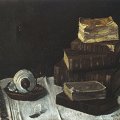 His mother having given him a box of paints during his long
convalescence following an attack of appendicitis, Matisse began to paint.
Nature morte aux livres (Still Life with Books).
His mother having given him a box of paints during his long
convalescence following an attack of appendicitis, Matisse began to paint.
Nature morte aux livres (Still Life with Books).
1891-1894
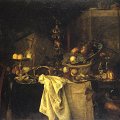 Having decided to become an artist, he moved to Paris and enrolled in
Bourguereau's class at the Academie Julien. He failed the entrance exam to
the Ecole des beaux-arts. Studied at the Ecole des arts decoratifs. Was
noticed by Gustave Moreau, who invited him to join his courses at the
Ecole des beaux-arts. In 1894, Marguerite, Matisse's daughter by Caroline
Joblaud, was born.
Having decided to become an artist, he moved to Paris and enrolled in
Bourguereau's class at the Academie Julien. He failed the entrance exam to
the Ecole des beaux-arts. Studied at the Ecole des arts decoratifs. Was
noticed by Gustave Moreau, who invited him to join his courses at the
Ecole des beaux-arts. In 1894, Marguerite, Matisse's daughter by Caroline
Joblaud, was born.
1895-1896
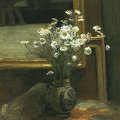 Officially admitted to the Ecole des beaux-arts (at the same time as
Albert Marquet), Matisse joined Gustave Moreau's studio. There he met
Camoin, Rouault, Manguin, and Rouveyre. Copied old masters at the Louvre.
Moved to 19 quai Saint-Michel in Paris. Showed at the Salon des Cent, then
at the Societe nationale des beaux-arts, where he sold two paintings,
including one to the government collection. Spent time in Belle-lie and
Brittany. The government bought La Liseuse (Woman Reading).
Officially admitted to the Ecole des beaux-arts (at the same time as
Albert Marquet), Matisse joined Gustave Moreau's studio. There he met
Camoin, Rouault, Manguin, and Rouveyre. Copied old masters at the Louvre.
Moved to 19 quai Saint-Michel in Paris. Showed at the Salon des Cent, then
at the Societe nationale des beaux-arts, where he sold two paintings,
including one to the government collection. Spent time in Belle-lie and
Brittany. The government bought La Liseuse (Woman Reading).
1897
First saw Impressionism paintings at the exhibition of the Caillebotte bequest in the Musee du Luxembourg. In April, showed again at the Salon de la Societe nationale des beaux-arts.
1898
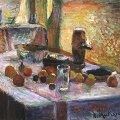 Married Amelie Parayre. Honeymooned in London, where he discovered
Turner. Stayed in Corsica, then in Fenouillet, Amelie's home near
Toulouse. Dazzled by the southern light, Matisse lightened his palette:
Paysage de Corse (Corsican Landscape). In June, first saw the work
of Signac and the neo-Impressionists at the Salon des Independants. Death
of Moreau, who was succeeded at the Ecole des beaux-arts by Fernand
Cormon.
Married Amelie Parayre. Honeymooned in London, where he discovered
Turner. Stayed in Corsica, then in Fenouillet, Amelie's home near
Toulouse. Dazzled by the southern light, Matisse lightened his palette:
Paysage de Corse (Corsican Landscape). In June, first saw the work
of Signac and the neo-Impressionists at the Salon des Independants. Death
of Moreau, who was succeeded at the Ecole des beaux-arts by Fernand
Cormon.
1899
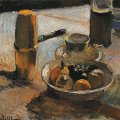 Birth of Jean Matisse. Matisse quit the Ecole des beaux-arts following
a dispute with Cormon, his new professor. Showed for the last time at the
Salon de la Societe nationale des beaux-arts. First attempts at sculpture,
inspired by Antoine-Louis Barye. From dealer Ambroise Vollard, Matisse
bought a drawing by Van Gogh, a plaster by Rodin, and Les Baigneuses
(Bathers) by Cezanne - this latter would influence his own painting,
notably a Self-Portrait.
Birth of Jean Matisse. Matisse quit the Ecole des beaux-arts following
a dispute with Cormon, his new professor. Showed for the last time at the
Salon de la Societe nationale des beaux-arts. First attempts at sculpture,
inspired by Antoine-Louis Barye. From dealer Ambroise Vollard, Matisse
bought a drawing by Van Gogh, a plaster by Rodin, and Les Baigneuses
(Bathers) by Cezanne - this latter would influence his own painting,
notably a Self-Portrait.
1900
Universal Exposition held in Paris - thanks to his friend Marquet, the cash-strapped Matisse was hired to join the team of decorators at the Grand Palais. In June, the family grew with the birth of Pierre. Amelie continued to work as a milliner until
Matisse attended courses alongside Andre Derain at the Academie Carriere and continued to study sculpture under Antoine Bourdelle at the Academie de la Grande Chaumiere. Another Self-Portrait; early still lifes with oranges; Interieur a I'harmonium (Interior with Harmonium).
1901
Convalescence in Switzerland following a bout of bronchitis. Derain introduced Matisse to Maurice de Vlaminck. Exhibited for the first time at the Salon des Independants.
1902
Sold one item at Berthe Weill's exhibition of work by students of Gustave Moreau. Due to lack of income, Matisse spent the winter at his parents' home in Bohain.
1903
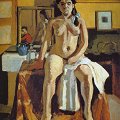 The first Salon d'automne was organized; Matisse showed two canvases.
Roger Marx noticed his work at the Salon des Independants. Apart from
brief trips to Paris, Matisse remained in Bohain until July, then moved to
Lesquielles-Saint-Germain nearby.
The first Salon d'automne was organized; Matisse showed two canvases.
Roger Marx noticed his work at the Salon des Independants. Apart from
brief trips to Paris, Matisse remained in Bohain until July, then moved to
Lesquielles-Saint-Germain nearby.
1904
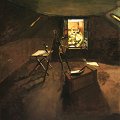 Moved back to Paris. Showed six works at the Salon des Independants.
His copy of Raphael's portrait of Baldassare Castiglione was bought by the
French government. Second group show at the Berthe Weill gallery and first
solo show (Works 1897-1903) at Ambroise Vollard's gallery, with a
catalogue foreword by Roger Marx. Spent the summer in Saint-Tropez.
Neo-Impressionist experiments: Luxe, calme et volupte (Luxuriance,
Peace, Pleasure). Significant presence at the Salon des
Independants-exhibited fourteen paintings and two sculptures.
Moved back to Paris. Showed six works at the Salon des Independants.
His copy of Raphael's portrait of Baldassare Castiglione was bought by the
French government. Second group show at the Berthe Weill gallery and first
solo show (Works 1897-1903) at Ambroise Vollard's gallery, with a
catalogue foreword by Roger Marx. Spent the summer in Saint-Tropez.
Neo-Impressionist experiments: Luxe, calme et volupte (Luxuriance,
Peace, Pleasure). Significant presence at the Salon des
Independants-exhibited fourteen paintings and two sculptures.
1905
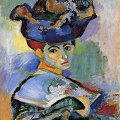 Matisse showed again at the Salon des Independants. Luxe, calme et
volupte was bought by Signac, but Matisse's Postimpressionism
experiments would go no further. Spent the summer in Collioure with Derain
and Camoin. All three exhibited at the Salon d'automne, notably
accompanied by Marquet, Vlaminck, and Manguin. Critic Louis Vauxelles, in
Gil Blas labeled them fauves (wild animals) who indulged in
an "orgy of pure colors", thereby coining the name Fauvism. The movement
enthused avant-garde collectors, notably the Steins, who immediately
bought La Femme au chapeau (Woman with Hat, a portrait of Mme.
Matisse who also posed for the portrait known as La Raie verte (The
Green Line). Rented a studio at
the Couvent des Oiseaux on rue de Sevres. Jeune Femme a I'ombrelle
(Young Woman with Parasol).
Matisse showed again at the Salon des Independants. Luxe, calme et
volupte was bought by Signac, but Matisse's Postimpressionism
experiments would go no further. Spent the summer in Collioure with Derain
and Camoin. All three exhibited at the Salon d'automne, notably
accompanied by Marquet, Vlaminck, and Manguin. Critic Louis Vauxelles, in
Gil Blas labeled them fauves (wild animals) who indulged in
an "orgy of pure colors", thereby coining the name Fauvism. The movement
enthused avant-garde collectors, notably the Steins, who immediately
bought La Femme au chapeau (Woman with Hat, a portrait of Mme.
Matisse who also posed for the portrait known as La Raie verte (The
Green Line). Rented a studio at
the Couvent des Oiseaux on rue de Sevres. Jeune Femme a I'ombrelle
(Young Woman with Parasol).
1906
Exhibited only one painting, Le Bonheur de vivre (Joy of Life at the Salon des Independants; bought by Leo Stein (who would sell it to Dr. Albert C. Barnes). May 10-26, traveled through Algeria, where he bought fabrics and pottery. The following summer, at Collioure, he would paint Nu bleu: Souvenir de Biskra (Blue Nude: Memory of Biskra). First lithographs. Introduced Picasso to the art of Africa.
1907
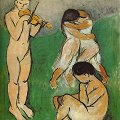 Matisse took up the motif of Nu bleu in sculpture, yielding
Nu couche a la chemise (Reclining Nude in Chemise). Traveled to
Tuscany (where he admired the work of Giotto) and Ravenna (where he became
interested in Byzantine art). A large canvas titled Le Luxe I
(Luxuriance I) was exhibited at the Salon d'automne. Thanks to
backing from Sarah Stein and the artist Hans Purrmann, Matisse founded the
Academie Matisse at the Couvent des Oiseaux. Portrait of
Marguerite.
Matisse took up the motif of Nu bleu in sculpture, yielding
Nu couche a la chemise (Reclining Nude in Chemise). Traveled to
Tuscany (where he admired the work of Giotto) and Ravenna (where he became
interested in Byzantine art). A large canvas titled Le Luxe I
(Luxuriance I) was exhibited at the Salon d'automne. Thanks to
backing from Sarah Stein and the artist Hans Purrmann, Matisse founded the
Academie Matisse at the Couvent des Oiseaux. Portrait of
Marguerite.
1908
Matisse moved his studio and his academy to the Hotel Biron near Les Invalides. Met Russian collector Sergei Shchukin, who introduced him to another Russian collector, Ivan Morozov. In summer, traveled to Berlin with Hans Purrmann. First show in New York (drawings, engravings, watercolors, and lithographs). Several of his canvases at the Salon d'automne already belonged to Shchukin, notably La Desserte, Harmonie rouge (The Red Room, Harmony in Red). Matisse published "Notes of a Painter" in the December issue of La Grande Revue.
1909
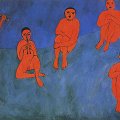 In the spring, Matisse painted L'Algerienne (Algerian Woman).
Shchukin commissioned two panels, La Danse and La Musique
for his Moscow residence. In the period until 1914, Shchukin would buy
nearly fifty works by Matisse. His paintings were shown at the Salon of
the Golden Fleece in Moscow. Matisse moved his operations from the Hotel
Biron to Issy-les-Moulineaux, where he had a studio built. Produced a
first state of the bas-relief Nu de dos (Nude Back). Traveled to
Berlin.
In the spring, Matisse painted L'Algerienne (Algerian Woman).
Shchukin commissioned two panels, La Danse and La Musique
for his Moscow residence. In the period until 1914, Shchukin would buy
nearly fifty works by Matisse. His paintings were shown at the Salon of
the Golden Fleece in Moscow. Matisse moved his operations from the Hotel
Biron to Issy-les-Moulineaux, where he had a studio built. Produced a
first state of the bas-relief Nu de dos (Nude Back). Traveled to
Berlin.
1910
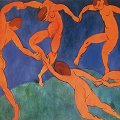 Retrospective of Matisse's work at the Bernheim-Jeune gallery in Paris;
show in New York; his work was also included in a group show in London of
Monet and the Post-Impressionists. Shchukin sees La Danse and La
Musique at the Salon d'automne; refuses to accept them, then changes
his mind upon returning to Russia. Closure of the Academie Matisse.
Matisse traveled to Munich with Marquet, becoming enthusiastic about a show
of Islamic art there. In the fall he left for Madrid, Cordoba, and
Seville. Jeune Fills aux tulipes (Girl with Tulips).
Retrospective of Matisse's work at the Bernheim-Jeune gallery in Paris;
show in New York; his work was also included in a group show in London of
Monet and the Post-Impressionists. Shchukin sees La Danse and La
Musique at the Salon d'automne; refuses to accept them, then changes
his mind upon returning to Russia. Closure of the Academie Matisse.
Matisse traveled to Munich with Marquet, becoming enthusiastic about a show
of Islamic art there. In the fall he left for Madrid, Cordoba, and
Seville. Jeune Fills aux tulipes (Girl with Tulips).
1911
Matisse painted in Madrid and admired the work of El Greco in Toledo. On returning to Issy-les-Moulineaux he began L'Atelier rouge (The Red Studio). Spent the summer in Collioure. At Shchukin's invitation, traveled in the autumn to Moscow and St. Petersburg, where he became interested in religious icons.
1912
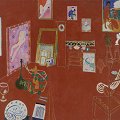 Spent the winter in Tangiers, returning with landscapes: Les
Acanthes (Acanthus). Show of his sculpture in New York. In October,
returned for a four-month stay in Morocco, where Camoin joined him.
Included in the Post-Impressionist Exhibition in London. Executed
several "interiors with goldfish".
Spent the winter in Tangiers, returning with landscapes: Les
Acanthes (Acanthus). Show of his sculpture in New York. In October,
returned for a four-month stay in Morocco, where Camoin joined him.
Included in the Post-Impressionist Exhibition in London. Executed
several "interiors with goldfish".
1913
Matisse's work was given a major place in the Armory Show in New York, while the Bernheim-Jeune gallery in Paris exhibited his Moroccan canvases. Second state of Nu de dos.
1914
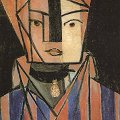 Matisse moved back to 19 quai Saint-Michel, to a different apartment.
Painted many scenes from his window: Vue de Notre-Dame (View of Notre
Dame). At the outbreak of war on August 3, Matisse attempted to enlist
but the authorities decided that the father of three should stick to his
painting. Matisse went to Toulouse, then Collioure, where he met Juan
Gris. Painted more windows, such as Porte-fenetre a Collioure (French
Window, Collioure), but his palette became darker and more black.
Tete blanche et rose (Pink and White Head).
Matisse moved back to 19 quai Saint-Michel, to a different apartment.
Painted many scenes from his window: Vue de Notre-Dame (View of Notre
Dame). At the outbreak of war on August 3, Matisse attempted to enlist
but the authorities decided that the father of three should stick to his
painting. Matisse went to Toulouse, then Collioure, where he met Juan
Gris. Painted more windows, such as Porte-fenetre a Collioure (French
Window, Collioure), but his palette became darker and more black.
Tete blanche et rose (Pink and White Head).
1915
Returned to Paris in the fall. Worked on engravings in his Issy studio. Exhibition in New York. Le Rideau jaune (The Yellow Curtain).
1916
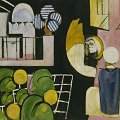 Third state of Nu de dos (1915-16). Completed Les Marocains
(The Moroccans) begun in 1915. Brief stay in Marseille: Groupe
d'arbres de I'Estaque (Stand of Trees in Estaque). A new series of
paintings was inaugurated with L'ltalienne (The Italian Woman)
inspired by a new model, Laurette, who sometimes posed with her
sisters-Les Trois Soeurs (The Three Sisters). Portrait of Greta Prozor;
La Lecon de piano (The Piano Lesson).
Third state of Nu de dos (1915-16). Completed Les Marocains
(The Moroccans) begun in 1915. Brief stay in Marseille: Groupe
d'arbres de I'Estaque (Stand of Trees in Estaque). A new series of
paintings was inaugurated with L'ltalienne (The Italian Woman)
inspired by a new model, Laurette, who sometimes posed with her
sisters-Les Trois Soeurs (The Three Sisters). Portrait of Greta Prozor;
La Lecon de piano (The Piano Lesson).
1917
Matisse's sons Jean and Pierre were drafted. In late October, Matisse traveled to Marseille. At the end of the year he moved into the Hotel Beau-Rivage in Nice. On December 31 Matisse visited Renoir in Cagnes-sur-Mer to show Renoir his paintings.
1918
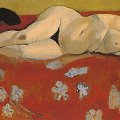 In January/February, showed at the Paul Guillaume gallery with Picasso.
Guillaume Apollinaire provided accompanying texts. In Nice, Matisse
painted mainly landscapes and portraits of his daughter Marguerite.
Returned to Paris and his studio in Issy, then went back to Nice, where he
stayed in the Hotel de la Mediterranee. Le Violoniste a lafenetre
(Violinist at the Window).
In January/February, showed at the Paul Guillaume gallery with Picasso.
Guillaume Apollinaire provided accompanying texts. In Nice, Matisse
painted mainly landscapes and portraits of his daughter Marguerite.
Returned to Paris and his studio in Issy, then went back to Nice, where he
stayed in the Hotel de la Mediterranee. Le Violoniste a lafenetre
(Violinist at the Window).
1919
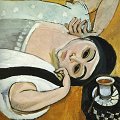 Exhibited at Bernheim-Jeune in Paris, and in London. Worked with a new
model, Antoinette Arnoux, into the following year. Summer at
Issy-les-Moulineaux. Diaghilev commissioned Matisse to do the sets and
costumes for the Stravinsky-Massine ballet, Le Chant du
rossignol.
Exhibited at Bernheim-Jeune in Paris, and in London. Worked with a new
model, Antoinette Arnoux, into the following year. Summer at
Issy-les-Moulineaux. Diaghilev commissioned Matisse to do the sets and
costumes for the Stravinsky-Massine ballet, Le Chant du
rossignol.
1920
Spent the summer in Etretat. Exhibited at the Salon d'automne. Matisse's work with Diaghilev took him to London.
1921
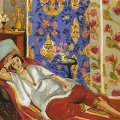 Matisse rented an apartment on place Charles-Felix in Nice, near the
sea (first on the fourth floor, then the fifth). Odalisque a la culotte
rouge (Odalisque with Red Harem Pants); Le Boudoir (The Boudoir); Femme au
canape (Woman and Sofa).
Matisse rented an apartment on place Charles-Felix in Nice, near the
sea (first on the fourth floor, then the fifth). Odalisque a la culotte
rouge (Odalisque with Red Harem Pants); Le Boudoir (The Boudoir); Femme au
canape (Woman and Sofa).
1922
More "odalisques", which become a veritable series based on a new model, Henriette Darricarere. Lithographs. Showed at Bernheim-Jeune (followed by two more shows in the next two years).
1923
The State Museum of New Western Art (the future Pushkin Museum) was founded in Moscow based on the collections of Morozov and Shchukin.
1924
A Matisse retrospective was held in Copenhagen, Stockholm, and Oslo.
1925-1926
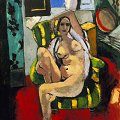 Spring 1925: Nu assis sur fond rouge (Seated Nude Against Red
Background). Summer trip to Rome, Naples, and Sicily, where Matisse
admired Byzantine mosaics. The following winter, he completed Figure
decorative sur fond ornemental (Decorative Figure against Ornamental
Background.
Spring 1925: Nu assis sur fond rouge (Seated Nude Against Red
Background). Summer trip to Rome, Naples, and Sicily, where Matisse
admired Byzantine mosaics. The following winter, he completed Figure
decorative sur fond ornemental (Decorative Figure against Ornamental
Background.
1927
In Pittsburgh, Pennsylvania, the annual Carnegie Prize was awarded to Matisse. Show in New York organized by Pierre Matisse. Another exhibition at the Bernheim-Jeune gallery in Paris. Odalisque a la culotte grise (Odalisque in Gray Harem Pants).
1928-1929
The Association des amis des artistes vivants donated Matisse's Nature morte au buffet vert (Still Life on Green Sideboard) to the Musee du Luxembourg. In the winter of 1928-29, the Valentine Gallery in New York hosted a show of his work since 1923.
1930
Fourth state of the bas-relief Nu de dos. Exhibited work in Berlin, Paris, and New York (the Pierre Matisse Gallery). Matisse had little time to paint due to extensive travel-New York, Chicago, Los Angeles, and San Francisco in February, followed by two months in Tahiti and Polynesia, then a return to the U.S. in the fall to sit on the jury for the Carnegie Prize. In late September had a meeting with his most important American collector, Dr. Albert C. Barnes, and visited the Barnes Foundation in Merion, near Philadelphia; Matisse returned there in December, Barnes having commissioned a large decorative painting for the main hall.
1931-1933
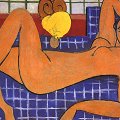 Major Matisse retrospective at The Museum of Modern Art in New York.
Apart from some drawings and engravings (notably his 1931 illustrations of
Mallarme's poetry for the publisher Skira), Matisse devoted most of his
time to the Barnes commission, developing the technique of cutting shapes
from gouache-coated paper. The first version of the Barnes Danse
was followed, after a trip to Italy (Turin, Milan, Padua), by a start on a
second version. Matisse went to Merion in 1933 to install the final
version.
Major Matisse retrospective at The Museum of Modern Art in New York.
Apart from some drawings and engravings (notably his 1931 illustrations of
Mallarme's poetry for the publisher Skira), Matisse devoted most of his
time to the Barnes commission, developing the technique of cutting shapes
from gouache-coated paper. The first version of the Barnes Danse
was followed, after a trip to Italy (Turin, Milan, Padua), by a start on a
second version. Matisse went to Merion in 1933 to install the final
version.
1934
Etchings and drawings for James Joyce's Ulysses published the following year. Another exhibition at the Pierre Matisse Gallery in New York.
1935
Lydia Delectorskaya began to pose regularly for Matisse, notably for a series of reclining nudes, including Le Reve (The Dream and Nu rose crevette (Large Reclining Nude). Began Nymphe dans la foret (Nymph in the Forest).
1936
Shows in London, Paris (Paul Rosenberg gallery), and San Francisco (Museum of Art). Publication of Tristan Tzara's Midis gagnes: poemes illustrated with six drawings by Matisse.
1937
 First real use of paper cutouts for the curtain, sets, and costumes of
Rouge et Noir (Etrange farandole), a ballet choreographed by
Massine to music by Shostakovich, performed by the Ballets de Monte-Carlo.
The city of Paris bought the second version of La Danse initially
executed for Merion. A new model, Helene Galitzine, began posing for the
early studies that would lead to La Blouse roumaine (Romanian
Blouse and Grande Robe bleue et mimosas (Lady in Blue).
First real use of paper cutouts for the curtain, sets, and costumes of
Rouge et Noir (Etrange farandole), a ballet choreographed by
Massine to music by Shostakovich, performed by the Ballets de Monte-Carlo.
The city of Paris bought the second version of La Danse initially
executed for Merion. A new model, Helene Galitzine, began posing for the
early studies that would lead to La Blouse roumaine (Romanian
Blouse and Grande Robe bleue et mimosas (Lady in Blue).
1938
At the urging of Jean Cassou, the French government bought Figure decorative sur fond ornemental. On advice from his doctor, Matisse left his seaside apartment for the hills of Cimiez outside Nice, moving into the former Hotel Regina. Le Bras (Arm).
1939
The ballet Rouge et Noir premiered in Monte Carlo. Matisse painted La Musique (Music). In October, working in the Hotel Regina, he returned to the unfinished Faune charmant la nymphe endormie (Faun Bewitching a Sleeping Nymph. Liseuse sur fond noir (Woman Reading Against Black Background).
1940
 Matisse traveled from Nice to visit Pierre Bonnard in Le Cannet. Spent
the spring in Paris, at 132 boulevard du Montparnasse. When the Germans
invaded France in May, Matisse decided to remain in the country, canceling
a trip to Rio de Janeiro. He also turned down an invitation to go to Mills
College in California. Fled south to Bordeaux, Ciboure, Saint-Gaudens,
Carcassone, and Marseille, finally returning to Nice. Painted Dormeuse,
table violette (Still Life with Sleeping Woman with Micheline Payot
as model, and Le Reve (The Dream with Nezy-Hamide Chawkat as model.
Final versions of La Blouse roumaine and its pendant canvas, once
again titled Le Reve.
Matisse traveled from Nice to visit Pierre Bonnard in Le Cannet. Spent
the spring in Paris, at 132 boulevard du Montparnasse. When the Germans
invaded France in May, Matisse decided to remain in the country, canceling
a trip to Rio de Janeiro. He also turned down an invitation to go to Mills
College in California. Fled south to Bordeaux, Ciboure, Saint-Gaudens,
Carcassone, and Marseille, finally returning to Nice. Painted Dormeuse,
table violette (Still Life with Sleeping Woman with Micheline Payot
as model, and Le Reve (The Dream with Nezy-Hamide Chawkat as model.
Final versions of La Blouse roumaine and its pendant canvas, once
again titled Le Reve.
1941
Matisse completed Nymphe dans la foret. Suffering from serious intestinal problems, he underwent major surgery in Dr. Rene Leriche's clinic in Lyon. He was obliged to work lying down, then sitting in a wheelchair for a while. In Lyon Matisse began a highly amicable correspondence with Andre Rouveyre (with whom he had previously exchanged just a few polite letters between 1905 and 1936), eventually numbering nearly 1,200 letters. Nature morte au coquillage (Still Life with Shell), Nature morte au magnolia (Still Life with Magnolia, bought by the French government in 1945), and Nature morte a la table de marbre vert (Still Life on Green Marble Table).
1942
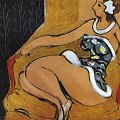 Louis Aragon paid a visit to Matisse in the Hotel Regina and saw the
drawings for Dessins, themes et variations to be published the
following year with a foreword by Aragon ("Matisse-en-France"). In
September, Monique Bourgeois was hired as a nursing companion; from
December 1942 to March 1943 she posed for four paintings, including
Jeune Fille en robe persane (Girl in Persian Gown).
Louis Aragon paid a visit to Matisse in the Hotel Regina and saw the
drawings for Dessins, themes et variations to be published the
following year with a foreword by Aragon ("Matisse-en-France"). In
September, Monique Bourgeois was hired as a nursing companion; from
December 1942 to March 1943 she posed for four paintings, including
Jeune Fille en robe persane (Girl in Persian Gown).
1943
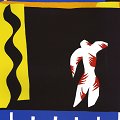 Matisse moved into Villa Le Reve, in Vence. From late winter into the
following autumn he pursued his experiments with paper cutouts, which led
to a commission from Teriade for the publication titled Jazz (late
December 1943, early 1944). Matisse executed lithographs to illustrate
Baudelaire's Les Fleurs du mal. Matisse's wife and daughter,
Marguerite, were arrested by the Gestapo for acts of resistance; Mme.
Matisse remained in prison for six months, while Marguerite was tortured
and sentenced to a concentration camp but managed to escape from the train
when bombing brought it to a halt near Belfort; she hid in the Vosges
forest. Montherlant's Pasiphae was published with engravings by Matisse.
When the Salon de la Liberation (Salon d'automne) organized a tribute to
Picasso, Matisse decided to exhibit Corbeille d'oranges (Basket of
Oranges) from his personal collection.
Matisse moved into Villa Le Reve, in Vence. From late winter into the
following autumn he pursued his experiments with paper cutouts, which led
to a commission from Teriade for the publication titled Jazz (late
December 1943, early 1944). Matisse executed lithographs to illustrate
Baudelaire's Les Fleurs du mal. Matisse's wife and daughter,
Marguerite, were arrested by the Gestapo for acts of resistance; Mme.
Matisse remained in prison for six months, while Marguerite was tortured
and sentenced to a concentration camp but managed to escape from the train
when bombing brought it to a halt near Belfort; she hid in the Vosges
forest. Montherlant's Pasiphae was published with engravings by Matisse.
When the Salon de la Liberation (Salon d'automne) organized a tribute to
Picasso, Matisse decided to exhibit Corbeille d'oranges (Basket of
Oranges) from his personal collection.
1945
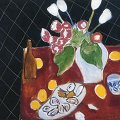 A Picasso-Matisse exhibition was held at the Victoria and Albert Museum
in London. In Paris, the Salon d'automne hosted a Matisse retrospective
(thirty-seven paintings), followed by a show at the Maeght gallery. Andre
Teriade published a special Matisse issue of Verve. The Musee
national d'art moderne was founded, for which Jean Cassou bought seven
Matisse paintings dating from 1907 to 1941.
A Picasso-Matisse exhibition was held at the Victoria and Albert Museum
in London. In Paris, the Salon d'automne hosted a Matisse retrospective
(thirty-seven paintings), followed by a show at the Maeght gallery. Andre
Teriade published a special Matisse issue of Verve. The Musee
national d'art moderne was founded, for which Jean Cassou bought seven
Matisse paintings dating from 1907 to 1941.
1946
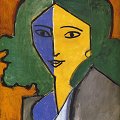 Matisse began his series of Vence interiors: Interieur rouge: Nature
morte sur table bleue (Red Interior: Still Life on Blue Table).
Teriade published Lettres de la religieuse portugaise with
illustrations by Matisse. Publication of "Visages", a series of
lithographs by Matisse with poetry by Pierre Reverdy. Exhibition in
Brussels with a catalogue by Jean Cassou; the Picasso-Matisse show traveled
to Glasgow, Birmingham, Brussels, and Amsterdam. L'Asie (Asia).
Matisse began his series of Vence interiors: Interieur rouge: Nature
morte sur table bleue (Red Interior: Still Life on Blue Table).
Teriade published Lettres de la religieuse portugaise with
illustrations by Matisse. Publication of "Visages", a series of
lithographs by Matisse with poetry by Pierre Reverdy. Exhibition in
Brussels with a catalogue by Jean Cassou; the Picasso-Matisse show traveled
to Glasgow, Birmingham, Brussels, and Amsterdam. L'Asie (Asia).
1947
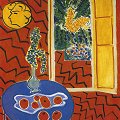 Publication of Rouveyre's Repli with twelve lithographs by
Matisse. The French government purchased Interieur jaune et bleu
(Yellow and Blue Interior). Jazz was finally published. On
December 4, Brother Rayssiguier and Matisse met for the first time - the
Dominican friar described his plan for a chapel in Vence with a
stained-glass window on the theme of the Heavenly Jerusalem.
Publication of Rouveyre's Repli with twelve lithographs by
Matisse. The French government purchased Interieur jaune et bleu
(Yellow and Blue Interior). Jazz was finally published. On
December 4, Brother Rayssiguier and Matisse met for the first time - the
Dominican friar described his plan for a chapel in Vence with a
stained-glass window on the theme of the Heavenly Jerusalem.
1948
Skira published Le Florilege des Amours de Ronsard illustrated by Matisse. Produced the initial designs for the stained-glass windows in the Vence chapel (La Jerusalem celeste and Le Fleuve de vie). Painted Grand Interieur rouge (Large Red Interior, purchased by the French government in 1949). Composition avec nu a la fougere noire (Composition, Nude with Black Fern brush drawing, donated by the artist to the French nation in 1950).
1949
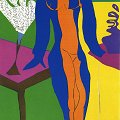 Matisse left Vence early in January, returning to the Hotel Regina in
Cimiez. He worked on the second and third versions of the window for Vence
(Vitrail bleu pale and L'Arbre de vie) as well as on the
designs for the three ceramic panels for the chapel. Monsignor Remond,
bishop of Nice, laid the first stone of the chapel on December 12.
Matisse left Vence early in January, returning to the Hotel Regina in
Cimiez. He worked on the second and third versions of the window for Vence
(Vitrail bleu pale and L'Arbre de vie) as well as on the
designs for the three ceramic panels for the chapel. Monsignor Remond,
bishop of Nice, laid the first stone of the chapel on December 12.
1950
Teriade published Poemes by Charles d'Orleans, handwritten and illustrated by Matisse. While celebrating his eightieth birthday in his bedroom in the Hotel Regina, Matisse painted portraits of three of his grandchildren on the ceiling. Designed liturgical vestments for the Vence chapel.
1951
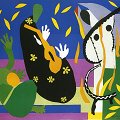 On June 25, Monsignor Remond consecrated the chapel in Vence; Matisse,
unwell, was unable to attend. Major Matisse exhibition traveled to Tokyo,
Kyoto, and Osaka. Matisse designed a stained-glass window, Poissons
chinois (Chinese Fish) for Teriade's Villa Natacha. In October,
Matisse was contacted by the mayor of Le Cateau-Cambresis and the
architect Ernest Gaillard. Plans to devote a museum to Matisse were drawn
up, followed by the naming of a school complex after him. Katia a la
robe jaune (Katia in a Yellow Dress).
On June 25, Monsignor Remond consecrated the chapel in Vence; Matisse,
unwell, was unable to attend. Major Matisse exhibition traveled to Tokyo,
Kyoto, and Osaka. Matisse designed a stained-glass window, Poissons
chinois (Chinese Fish) for Teriade's Villa Natacha. In October,
Matisse was contacted by the mayor of Le Cateau-Cambresis and the
architect Ernest Gaillard. Plans to devote a museum to Matisse were drawn
up, followed by the naming of a school complex after him. Katia a la
robe jaune (Katia in a Yellow Dress).
1952
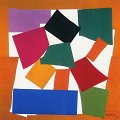 Series of Nus bleus (Blue Nudes). In October, at his Hotel Regina
studio, Matisse gave Gaillard instructions concerning the architectural
design of the nursery school. On November 8, the Musee Henri-Matisse was
inaugurated in the town hall of Le Cateau. La Tristesse du roi (The
Sorrow of the King) was exhibited at the Salon de mai; Jean Cassou and
Georges Salles purchased it for the French nation.
Series of Nus bleus (Blue Nudes). In October, at his Hotel Regina
studio, Matisse gave Gaillard instructions concerning the architectural
design of the nursery school. On November 8, the Musee Henri-Matisse was
inaugurated in the town hall of Le Cateau. La Tristesse du roi (The
Sorrow of the King) was exhibited at the Salon de mai; Jean Cassou and
Georges Salles purchased it for the French nation.
1953
Matisse showed paper cutouts at Berggruen & Co. in Paris, with a catalogue by Teriade. On November 6, the third design for the nursery school, incorporating Matisse's modifications, was presented in Lille to Minister of Education Andre Marie.
1954
Spent the summer at La Bastide rouge, between Vence and Cagnes-sur-Mer. In September he worked on the paper cutout design of the Rockefeller Memorial Rose Window. Matisse died from a heart attack on November 3. He was buried at Cimiez.
Henri Matisse Art

|
|
More
Articles
 Art Encyclopedia A world history of art in articles.
Art Encyclopedia A world history of art in articles.
Modernism
Henri Matisse
Life and work.
The Music. The Dance.
Simply painting and color.
Paper cutouts.
Art
 Art Wallpapers Art image collections for your desktop.
Art Wallpapers Art image collections for your desktop.
Munch Art, $19
(75 pictures)
Malevich Art, $25
(105 pictures)
Modigliani Art, $29
(135 pictures)
Klee Art, $25
(150 pictures)
Miro Art, $35
(150 pictures)
Matisse Art, $29
(180 pictures)
Picasso Art, $29
(175 pictures)
Dali Art, $35
(275 pictures)
Chagall Art, $35
(175 pictures)
